The Wannier-Mott Exciton, Bound Exciton, and Optical Phonon Replicas of Single-Crystal GaSe
Abstract
:1. Introduction
2. Materials and Methods
2.1. Sample Growth and Preparation
2.2. Characterization
3. Results and Discussion
4. Conclusions
Author Contributions
Funding
Data Availability Statement
Acknowledgments
Conflicts of Interest
References
- Abderrahmane, A.; Jung, P.-G.; Kim, N.-H.; Ko, P.J.; Sandhu, A. Gate-Tunable Optoelectronic Properties of a Nano-Layered GaSe Photodetector. Opt. Mater. Express 2017, 7, 587–592. [Google Scholar] [CrossRef]
- Saroj, R.K.; Guha, P.; Lee, S.; Yoo, D.; Lee, E.; Lee, J.; Kim, M.; Yi, G.-C. Photodetector Arrays Based on MBE-Grown GaSe/Graphene Heterostructure. Adv. Opt. Mater. 2022, 10, 2200332. [Google Scholar] [CrossRef]
- Chen, Z.; Chen, Q.; Chai, Z.; Wei, B.; Wang, J.; Liu, Y.; Shi, Y.; Wang, Z.; Li, J. Ultrafast Growth of High-Quality Large-Sized GaSe Crystals by Liquid Metal Promoter. Nano Res. 2022, 15, 4677–4681. [Google Scholar] [CrossRef]
- Sorifi, S.; Kaushik, S.; Singh, R. A GaSe/Si-Based Vertical 2D/3D Heterojunction for High-Performance Self-Driven Photodetectors. Nanoscale Adv. 2022, 4, 479–490. [Google Scholar] [CrossRef]
- Zappia, M.I.; Bianca, G.; Bellani, S.; Curreli, N.; Sofer, Z.; Serri, M.; Najafi, L.; Piccinni, M.; Oropesa-Nuñez, R.; Marvan, P.; et al. Two-Dimensional Gallium Sulfide Nanoflakes for UV-Selective Photoelectrochemical-Type Photodetectors. J. Phys. Chem. C 2021, 125, 11857–11866. [Google Scholar] [CrossRef] [PubMed]
- Zappia, M.I.; Bianca, G.; Bellani, S.; Serri, M.; Najafi, L.; Oropesa-Nuñez, R.; Martín-García, B.; Bouša, D.; Sedmidubský, D.; Pellegrini, V.; et al. Solution-Processed GaSe Nanoflake-Based Films for Photoelectrochemical Water Splitting and Photoelectrochemical-Type Photodetectors. Adv. Funct. Mater. 2020, 30, 1909572. [Google Scholar] [CrossRef]
- Yang, Z.; Chen, H.; Wu, F.; Hou, Y.; Qiao, J.; Ma, X.; Bai, H.; Ma, B.; Li, J. Investigation on Photocatalytic Property of SiH/GaSe and SiH/InSe Heterojunctions for Photocatalytic Water Splitting. Int. J. Hydrogen Energy 2022, 47, 31295–31308. [Google Scholar] [CrossRef]
- Zhang, W.X.; Hou, J.T.; Bai, M.; He, C.; Wen, J.R. Construction of Novel ZnO/Ga2SSe (GaSe) VdW Heterostructures as Efficient Catalysts for Water Splitting. Appl. Surf. Sci. 2023, 634, 157648. [Google Scholar] [CrossRef]
- Ahmad, H.; Reduan, S.A.; Sharbirin, A.S.; Ismail, M.F.; Zulkifli, M.Z. Q-Switched Thulium/Holmium Fiber Laser with Gallium Selenide. Optik 2018, 175, 87–92. [Google Scholar] [CrossRef]
- Yu, Q.; Liu, F.; Zhang, Y.; Deng, H.; Shu, B.; Zhang, J.; Yi, T.; Dai, Y.; Fan, C.; Su, W.; et al. Lab-on-Fiber Based on Optimized Gallium Selenide for Femtosecond Mode-Locked Lasers and Fiber-Compatible Photodetectors. Adv. Photonics Res. 2023, 4, 2200283. [Google Scholar] [CrossRef]
- Guo, J.; Xie, J.-J.; Li, D.-J.; Yang, G.-L.; Chen, F.; Wang, C.-R.; Zhang, L.-M.; Andreev, Y.M.; Kokh, K.A.; Lanskii, G.V.; et al. Doped GaSe Crystals for Laser Frequency Conversion. Light Sci. Appl. 2015, 4, e362. [Google Scholar] [CrossRef]
- Elafandi, S.; Ahmadi, Z.; Azam, N.; Mahjouri-Samani, M. Gas-Phase Formation of Highly Luminescent 2D GaSe Nanoparticle Ensembles in a Nonequilibrium Laser Ablation Process. Nanomaterials 2020, 10, 908. [Google Scholar] [CrossRef]
- Liu, G.; Xia, S.; Hou, B.; Gao, T.; Zhang, R. Mechanical Stabilities and Nonlinear Properties of Monolayer Gallium Selenide under Tension. Mod. Phys. Lett. B 2015, 29, 1550049. [Google Scholar] [CrossRef]
- Karvonen, L.; Säynätjoki, A.; Mehravar, S.; Rodriguez, R.D.; Hartmann, S.; Zahn, D.R.T.; Honkanen, S.; Norwood, R.A.; Peyghambarian, N.; Kieu, K.; et al. Investigation of Second- and Third-Harmonic Generation in Few-Layer Gallium Selenide by Multiphoton Microscopy. Sci. Rep. 2015, 5, 10334. [Google Scholar] [CrossRef]
- Shevchenko, O.N.; Nikolaev, N.A.; Antsygin, V.D. Estimation of the Nonlinear-Optical Coefficient of GaSe:S Crystals According to Electro-Optical Measurements. In Proceedings of the XVI International Conference on Pulsed Lasers and Laser Applications, Tomsk, Russia, 10–15 September 2023; Volume 12920, p. 129200G. [Google Scholar]
- Thanh, L.C.; Depeursinge, C. Fine Structure of the Exciton Spectrum in GaSe. Solid State Commun. 1978, 25, 499–503. [Google Scholar] [CrossRef]
- Bergeron, A.; Ibrahim, J.; Leonelli, R.; Francoeur, S. Oxidation Dynamics of Ultrathin GaSe Probed through Raman Spectroscopy. Appl. Phys. Lett. 2017, 110, 241901. [Google Scholar] [CrossRef]
- Hoff, R.M.; Irwin, J.C.; Lieth, R.M.A. Raman Scattering in GaSe. Can. J. Phys. 1975, 53, 1606–1614. [Google Scholar] [CrossRef]
- Irwin, J.C.; Hoff, R.M.; Clayman, B.P.; Bromley, R.A. Long Wavelength Lattice Vibrations in GaS and GaSe. Solid State Commun. 1973, 13, 1531–1536. [Google Scholar] [CrossRef]
- Wieting, T.J.; Verble, J.L. Interlayer Bonding and the Lattice Vibrations of β-GaSe. Phys. Rev. B 1972, 5, 1473–1479. [Google Scholar] [CrossRef]
- Capozzi, V.; Montagna, M. Optical Spectroscopy of Extrinsic Recombinations in Gallium Selenide. Phys. Rev. B 1989, 40, 3182–3190. [Google Scholar] [CrossRef]
- Wei, C.; Chen, X.; Li, D.; Su, H.; He, H.; Dai, J.-F. Bound Exciton and Free Exciton States in GaSe Thin Slab. Sci. Rep. 2016, 6, 33890. [Google Scholar] [CrossRef]
- Zalamai, V.V.; Syrbu, N.N.; Stamov, I.G.; Beril, S.I. Wannier–Mott Excitons in GaSe Single Crystals. J. Opt. 2020, 22, 85402. [Google Scholar] [CrossRef]
- Usman, M.; Golovynskyi, S.; Dong, D.; Lin, Y.; Yue, Z.; Imran, M.; Li, B.; Wu, H.; Wang, L. Raman Scattering and Exciton Photoluminescence in Few-Layer GaSe: Thickness- and Temperature-Dependent Behaviors. J. Phys. Chem. C 2022, 126, 10459–10468. [Google Scholar] [CrossRef]
- Rakhlin, M.V.; Evropeitsev, E.A.; Eliseyev, I.A.; Toropov, A.A.; Shubina, T.V. Exciton Structure and Recombination Dynamics in GaSe Crystals. Bull. Russ. Acad. Sci. Phys. 2023, 87, S60–S65. [Google Scholar] [CrossRef]
- Akhundov, G.A.; Gasanova, N.A.; Nizametdinova, M.A. Optical Absorption, Reflection, and Dispersion of GaS and GaSe Layer Crystals. Phys. Status Solidi 1966, 15, K109–K113. [Google Scholar] [CrossRef]
- Balzarotti, A.; Piacentini, M. Excitonic Effect at the Direct Absorption Edges of GaSe. Solid State Commun. 1972, 10, 421–425. [Google Scholar] [CrossRef]
- Gauthier, M.; Polian, A.; Besson, J.M.; Chevy, A. Optical Properties of Gallium Selenide under High Pressure. Phys. Rev. B 1989, 40, 3837–3854. [Google Scholar] [CrossRef]
- Isik, M.; Tugay, E.; Gasanly, N.M. Temperature-Dependent Optical Properties of GaSe Layered Single Crystals. Philos. Mag. 2016, 96, 2564–2573. [Google Scholar] [CrossRef]
- Choi, S.G.; Levi, D.H.; Martinez-Tomas, C.; Muñoz Sanjosé, V. Above-Bandgap Ordinary Optical Properties of GaSe Single Crystal. J. Appl. Phys. 2009, 106, 53517. [Google Scholar] [CrossRef]
- Meyer, F.; de Kluizenaar, E.E.; Engelsen, D. den Ellipsometric Determination of the Optical Anisotropy of Gallium Selenide. J. Opt. Soc. Am. 1973, 63, 529–532. [Google Scholar] [CrossRef]
- Le, L.V.; Nguyen, T.-T.; Nguyen, X.A.; Cuong, D.D.; Nguyen, T.H.; Nguyen, V.Q.; Cho, S.; Kim, Y.D.; Kim, T.J. A Systematic Study of the Temperature Dependence of the Dielectric Function of GaSe Uniaxial Crystals from 27 to 300 K. Nanomaterials 2024, 14, 839. [Google Scholar] [CrossRef]
- Voitchovsky, J.P.; Mercier, A. Photoluminescence OfGaSe. Nuovo Cim. B 1974, 22, 273–292. [Google Scholar] [CrossRef]
- Antonioli, G.; Bianchi, D.; Emiliani, U.; Podini, P.; Franzosi, P. Optical Properties and Electron-Phonon Interaction in GaSe. Nuovo Cim. B 1979, 54, 211–227. [Google Scholar] [CrossRef]
- Le Toullec, R.; Piccioli, N.; Chervin, J.C. Optical Properties of the Band-Edge Exciton in GaSe Crystals at 10 K. Phys. Rev. B 1980, 22, 6162–6170. [Google Scholar] [CrossRef]
- Capozzi, V. A Minafra Photoluminescence Properties of Cu-Doped GaSe. J. Phys. C Solid State Phys. 1981, 14, 4335. [Google Scholar] [CrossRef]
- Del Pozo-Zamudio, O.; Schwarz, S.; Sich, M.; Akimov, I.A.; Bayer, M.; Schofield, R.C.; Chekhovich, E.A.; Robinson, B.J.; Kay, N.D.; Kolosov, O.V.; et al. Photoluminescence of Two-Dimensional GaTe and GaSe Films. 2D Mater. 2015, 2, 35010. [Google Scholar] [CrossRef]
- Chen, G.; Zhang, L.; Li, L.; Cheng, F.; Fu, X.; Li, J.; Pan, R.; Cao, W.; Chan, A.S.; Panin, G.N.; et al. GaSe Layered Nanorods Formed by Liquid Phase Exfoliation for Resistive Switching Memory Applications. J. Alloys Compd. 2020, 823, 153697. [Google Scholar] [CrossRef]
- Wang, T.; Li, J.; Zhao, Q.; Yin, Z.; Zhang, Y.; Chen, B.; Xie, Y.; Jie, W. High-Quality GaSe Single Crystal Grown by the Bridgman Method. Materials 2018, 11, 186. [Google Scholar] [CrossRef]
- Lim, S.Y.; Lee, J.-U.; Kim, J.H.; Liang, L.; Kong, X.; Nguyen, T.T.H.; Lee, Z.; Cho, S.; Cheong, H. Polytypism in Few-Layer Gallium Selenide. Nanoscale 2020, 12, 8563–8573. [Google Scholar] [CrossRef]
- Shih, Y.-T.; Lin, D.-Y.; Tseng, B.-C.; Kao, Y.-M.; Hwang, S.-B.; Lin, C.-F. Structural and Optical Characterization of GaS1-xSex Layered Mixed Crystals Grown by Chemical Vapor Transport. Mater. Today Commun. 2023, 37, 107047. [Google Scholar] [CrossRef]
- Bourdon, A.; Khelladi, F. Selection Rule in the Fundamental Direct Absorption of GaSe. Solid State Commun. 1971, 9, 1715–1717. [Google Scholar] [CrossRef]
- Capozzi, V. Direct and Indirect Excitonic Emission in GaSe. Phys. Rev. B 1981, 23, 836–840. [Google Scholar] [CrossRef]
- Zhang, D.; Jia, T.; Dong, R.; Chen, D. Temperature-Dependent Photoluminescence Emission from Unstrained and Strained GaSe Nanosheets. Materials 2017, 10, 1282. [Google Scholar] [CrossRef]
- Mercier, A.; Mooser, E.; Voitchovsky, J.P. Resonant Exciton in GaSe. Phys. Rev. B 1975, 12, 4307–4311. [Google Scholar] [CrossRef]
- Ishii, Y.; Sasaki, Y.; Hamaguchi, C.; Nakai, J. Transverse Electroreflectance of GaSe at the Fundamental Absorption Edge. Solid State Commun. 1975, 17, 451–454. [Google Scholar] [CrossRef]
- Matsumura, T.; Sudo, M.; Tatsuyama, C.; Ichimura, S. Photoluminescence in GaSe. Phys. Status Solidi 1977, 43, 685–693. [Google Scholar] [CrossRef]
- Yang, L.; Motohisa, J.; Fukui, T. Excitation-Power-Density-Dependent Micro-Photoluminescence from Selective-Area-Grown Hexagonal Nanopillars with Single InGaAs/GaAs Quantum Well on the GaAs (111)B Substrate. In Proceedings of the 2007 7th IEEE Conference on Nanotechnology (IEEE NANO), Hong Kong, China, 2–5 August 2007; pp. 664–669. [Google Scholar]
- Pan, C.-J.; Lin, K.-F.; Hsieh, W.-F. Acoustic and Optical Phonon Assisted Formation of Biexcitons. Appl. Phys. Lett. 2007, 91, 111907. [Google Scholar] [CrossRef]
- Feng, Z.C.; Li, Q.; Wan, L.; Xu, G. Variation of Phonon Coupling Factors in the Photoluminescence of Cadmium Telluride by Variable Excitation Power. Opt. Mater. Express 2017, 7, 808–816. [Google Scholar] [CrossRef]
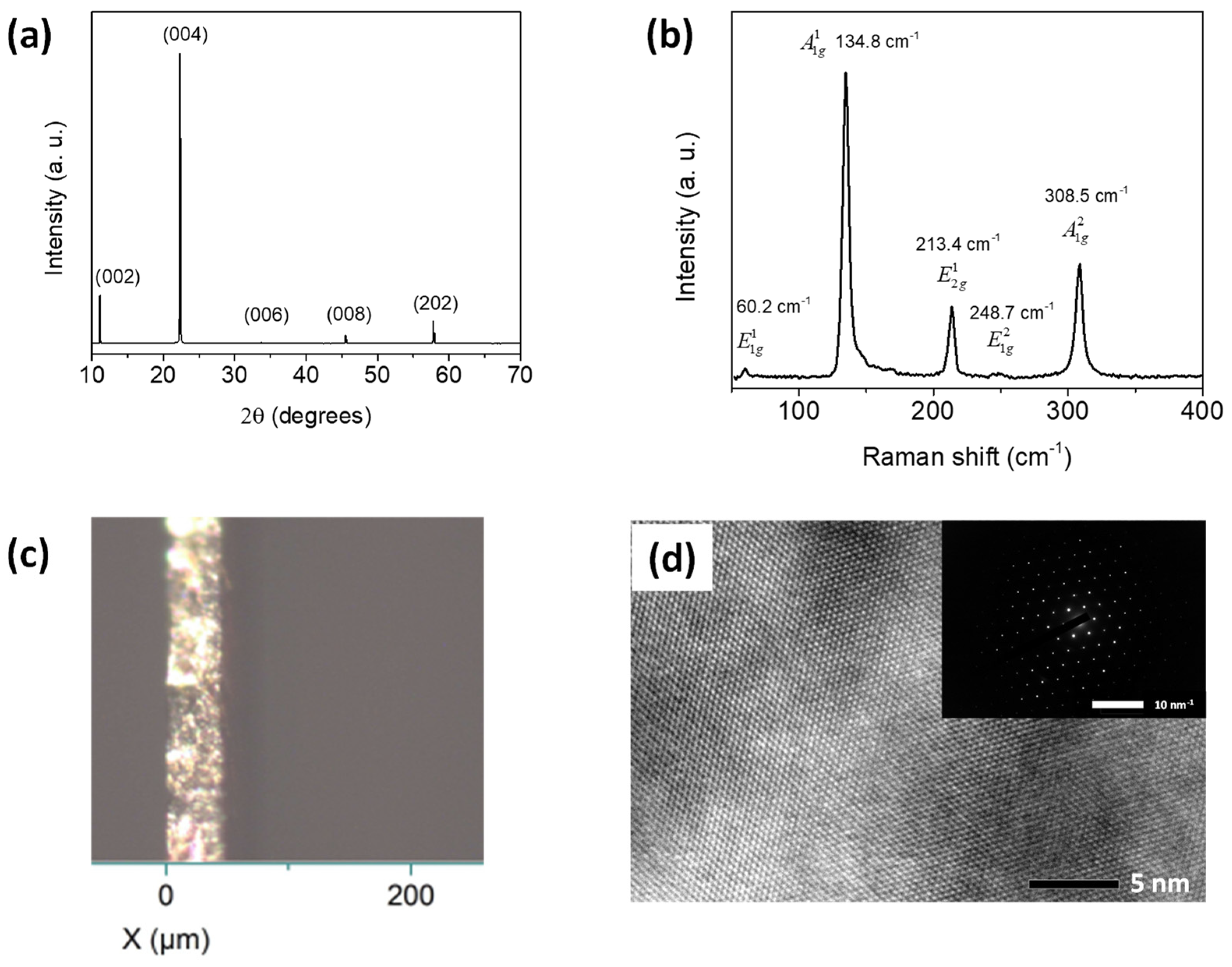
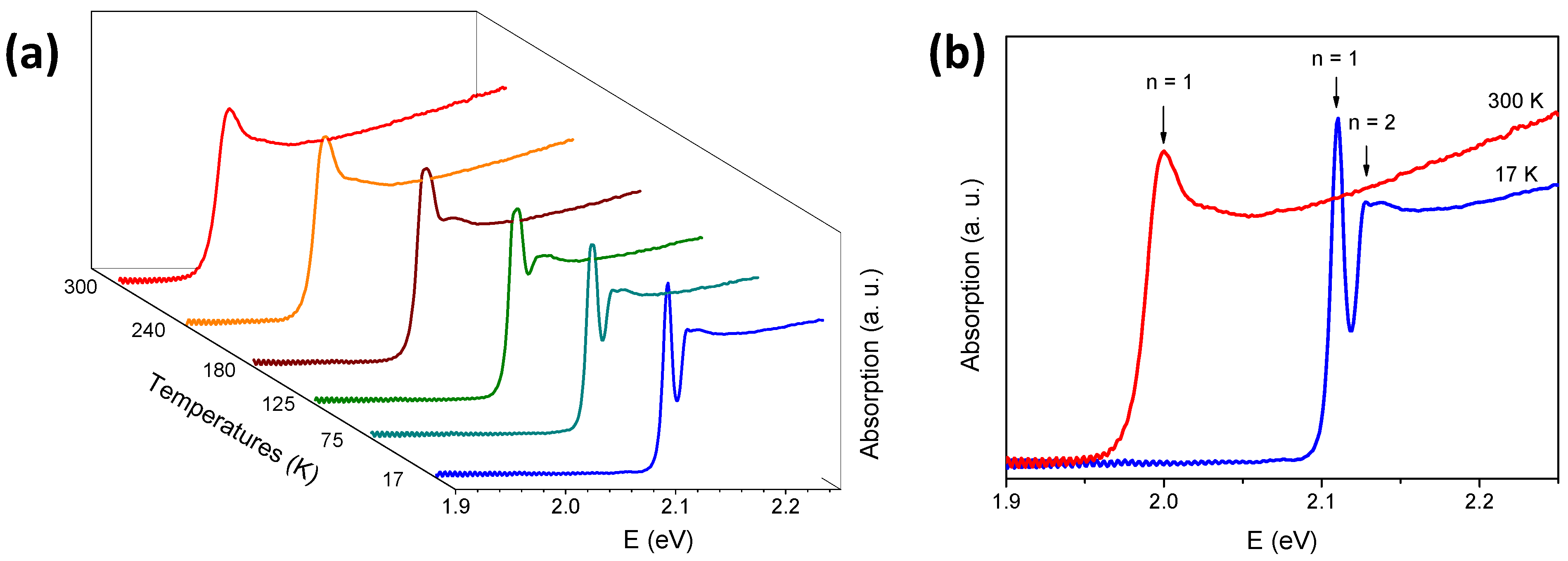
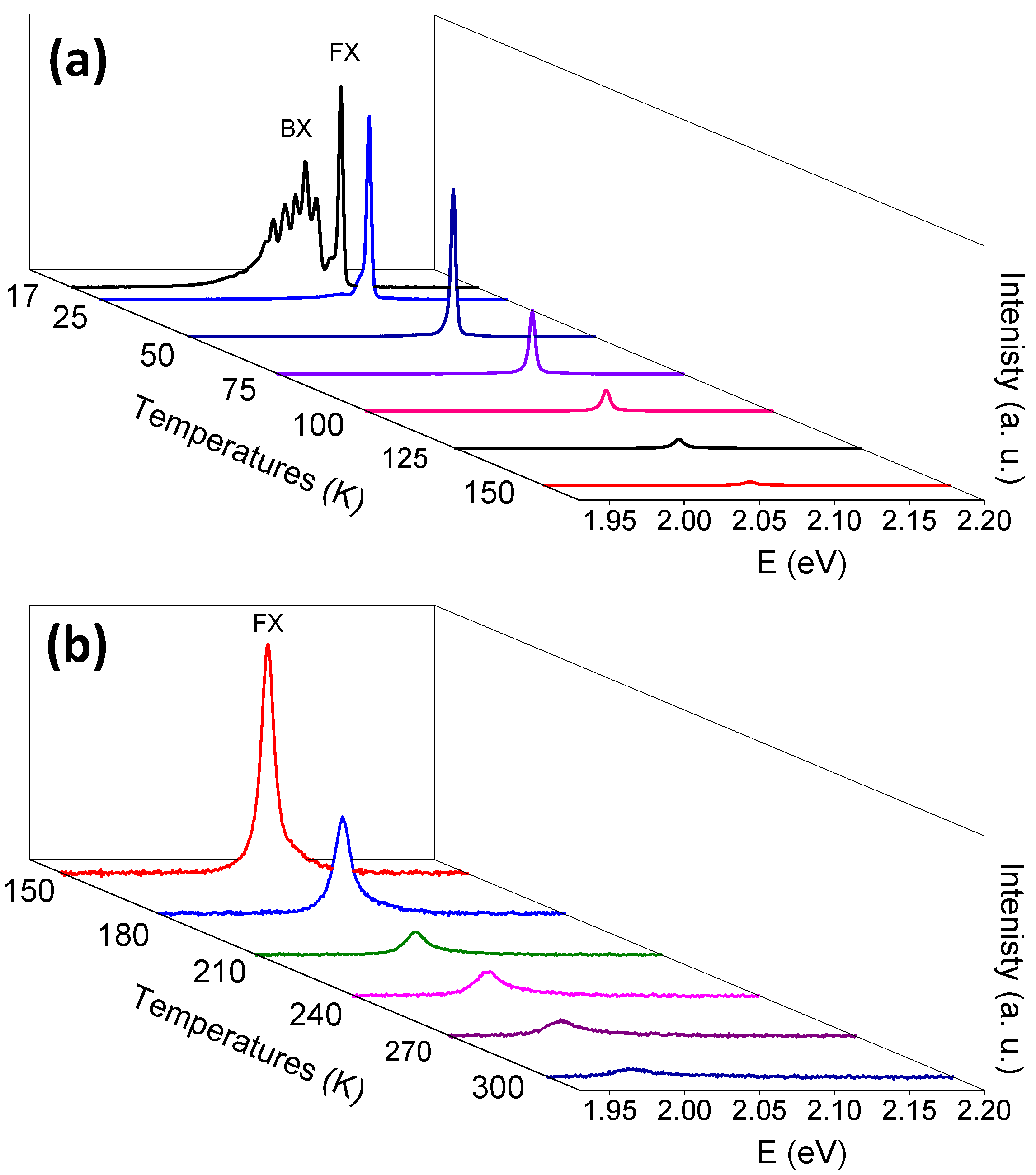
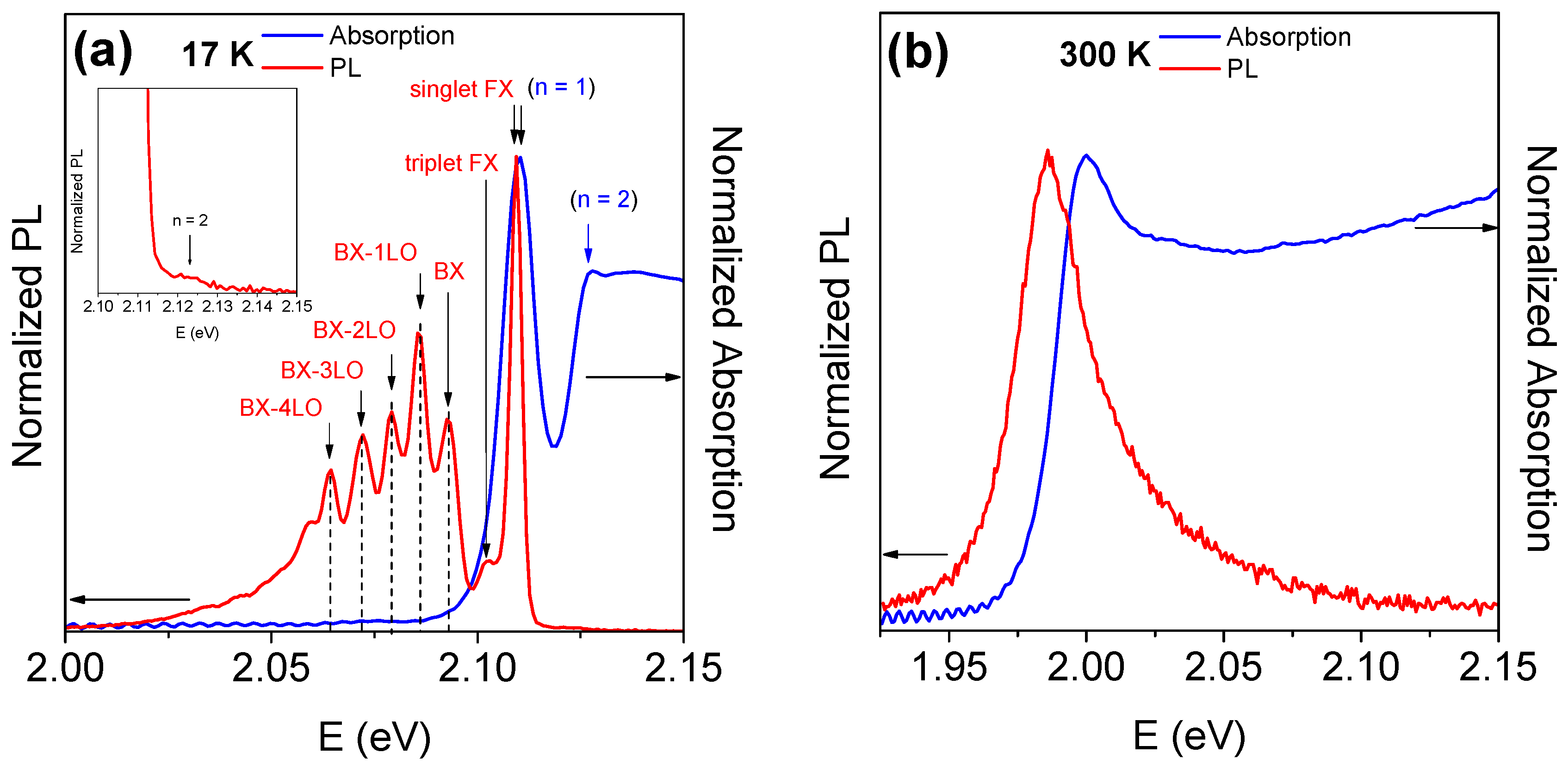

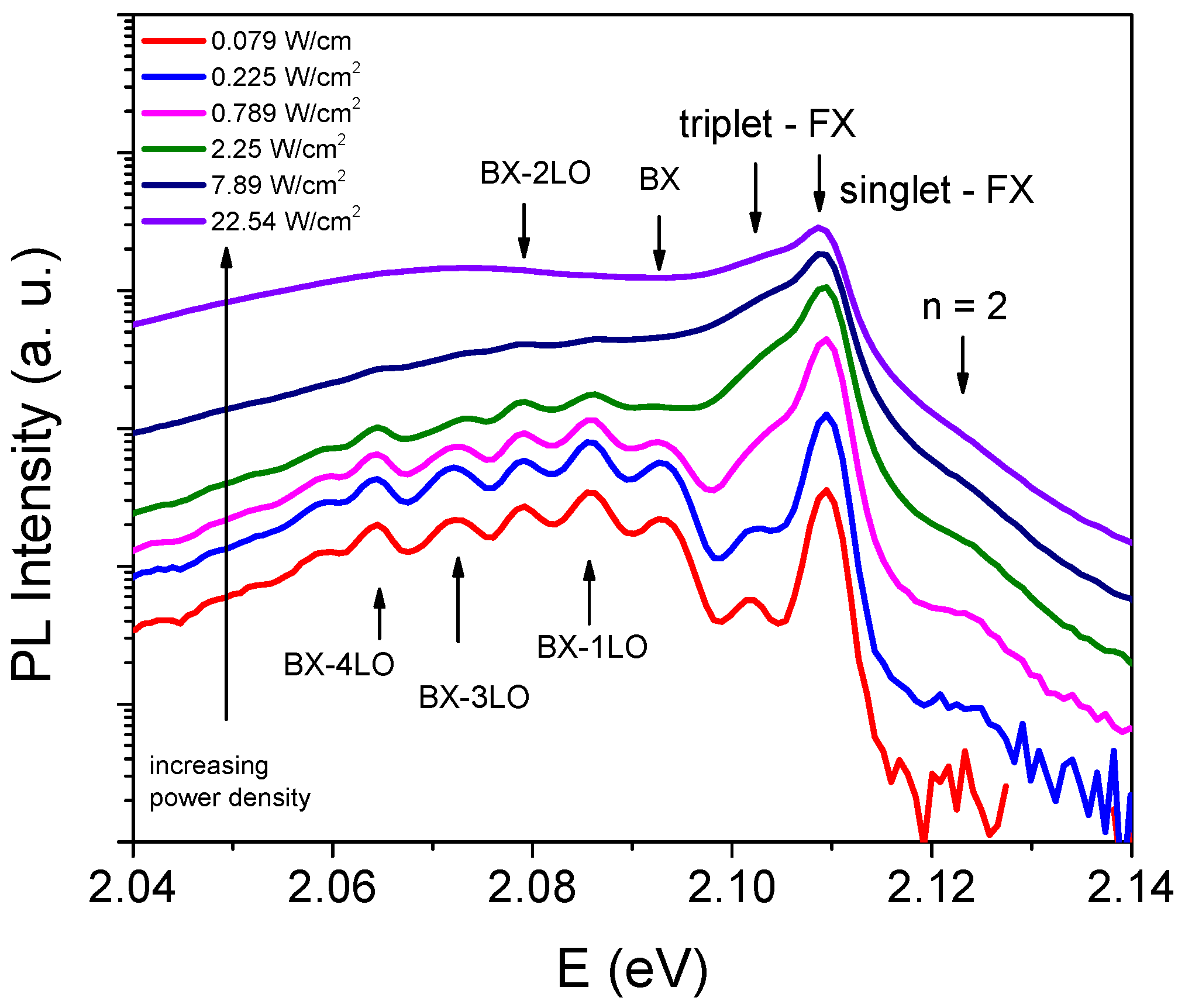
| Exciton States | (eV) | (meVK) | (meVK) | (meV) | |
|---|---|---|---|---|---|
| Absorption | 2.111 ± 0.002 | −0.5 ± 0.7 | 103 ± 10 | 18.6 ± 3.5 | |
| 2.128 ± 0.001 | −0.6 ± 0.5 | −111 ± 78 | 20.8 ± 7.8 | ||
| PL | 2.111 ± 0.001 | −0.8 ± 0.4 | −121 ± 7 | 20.4 ± 2 | |
| 2.127 ± 0.001 | −1.1 ± 0.1 | −217 ± 40 | 29.2 ± 2 |
Disclaimer/Publisher’s Note: The statements, opinions and data contained in all publications are solely those of the individual author(s) and contributor(s) and not of MDPI and/or the editor(s). MDPI and/or the editor(s) disclaim responsibility for any injury to people or property resulting from any ideas, methods, instructions or products referred to in the content. |
© 2024 by the authors. Licensee MDPI, Basel, Switzerland. This article is an open access article distributed under the terms and conditions of the Creative Commons Attribution (CC BY) license (https://creativecommons.org/licenses/by/4.0/).
Share and Cite
Le, L.V.; Huong, T.T.T.; Nguyen, T.-T.; Nguyen, X.A.; Nguyen, T.H.; Cho, S.; Kim, Y.D.; Kim, T.J. The Wannier-Mott Exciton, Bound Exciton, and Optical Phonon Replicas of Single-Crystal GaSe. Crystals 2024, 14, 539. https://doi.org/10.3390/cryst14060539
Le LV, Huong TTT, Nguyen T-T, Nguyen XA, Nguyen TH, Cho S, Kim YD, Kim TJ. The Wannier-Mott Exciton, Bound Exciton, and Optical Phonon Replicas of Single-Crystal GaSe. Crystals. 2024; 14(6):539. https://doi.org/10.3390/cryst14060539
Chicago/Turabian StyleLe, Long V., Tran Thi Thu Huong, Tien-Thanh Nguyen, Xuan Au Nguyen, Thi Huong Nguyen, Sunglae Cho, Young Dong Kim, and Tae Jung Kim. 2024. "The Wannier-Mott Exciton, Bound Exciton, and Optical Phonon Replicas of Single-Crystal GaSe" Crystals 14, no. 6: 539. https://doi.org/10.3390/cryst14060539
APA StyleLe, L. V., Huong, T. T. T., Nguyen, T.-T., Nguyen, X. A., Nguyen, T. H., Cho, S., Kim, Y. D., & Kim, T. J. (2024). The Wannier-Mott Exciton, Bound Exciton, and Optical Phonon Replicas of Single-Crystal GaSe. Crystals, 14(6), 539. https://doi.org/10.3390/cryst14060539









